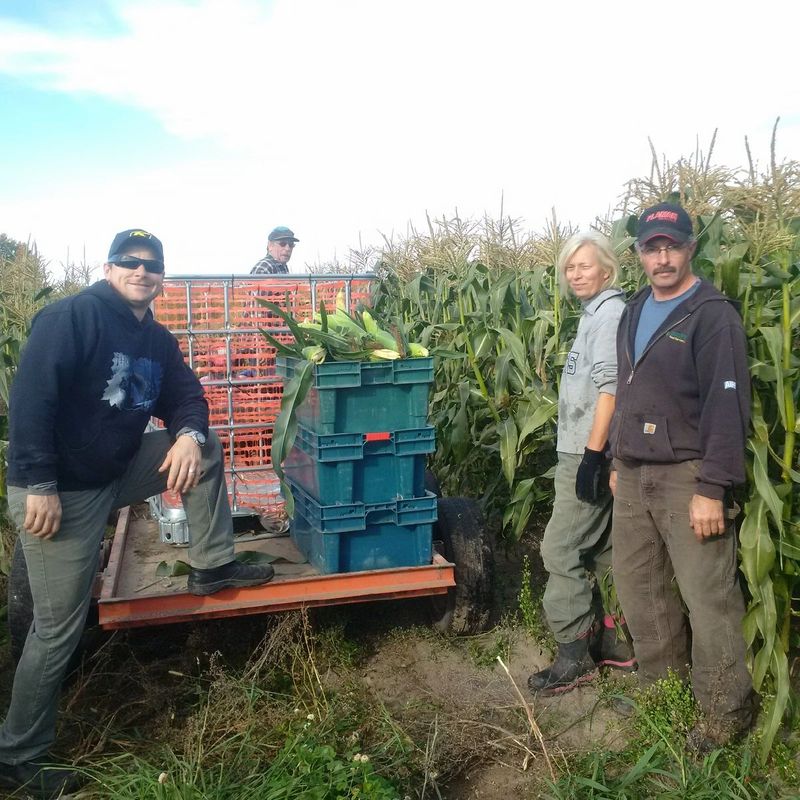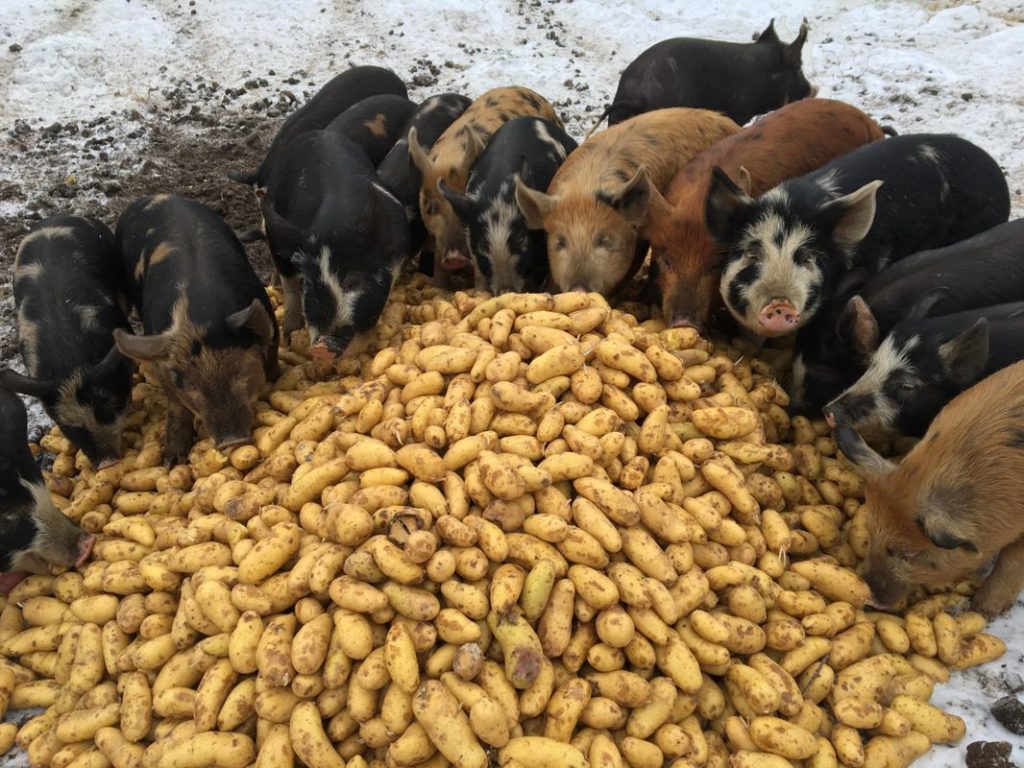 Diversification, certified-organic, and following nature’s patterns to grow quality food, educate the community on nutrition and growing, and aspiring for a regional food hub for increased food security
Diversification, certified-organic, and following nature’s patterns to grow quality food, educate the community on nutrition and growing, and aspiring for a regional food hub for increased food security
By Trina Moyles
“A potato is not just a potato – we can get lengthy on that conversation,” chuckles Janice Shelton, an organic farmer and educator at Sand Springs Ranch in Lac La Biche, Alberta.
Janice and her husband, Ty Shelton, have been running Sand Springs Ranch, a certified organic operation, with a philosophy for biodiversity for over 35 years. They raise grass-finished beef, pasture-raised pork, and grow organic vegetables, and both table and seed potatoes in northeastern Alberta. “We are a small family farm. We consider ourselves small compared to the big guys.”
The Sheltons are a true family operation, working alongside their son, Tyler, who also works as an instrumentation, daughter, Jolene, who manages the market garden production, and their two grandsons.
Biodiversity and diversification are at the heart of what the Sheltons do at Sand Springs Ranch, from relying on the unique skillsets of every family member to feeding their cattle a blend of hay from a variety of fields – all with different soil biology and nutrients – to diversifying their products and marketing strategies, to cultivating lesser known varieties of potatoes.
“There aren’t only two to three kinds of potatoes,” explains Janice. “There are thousands.”
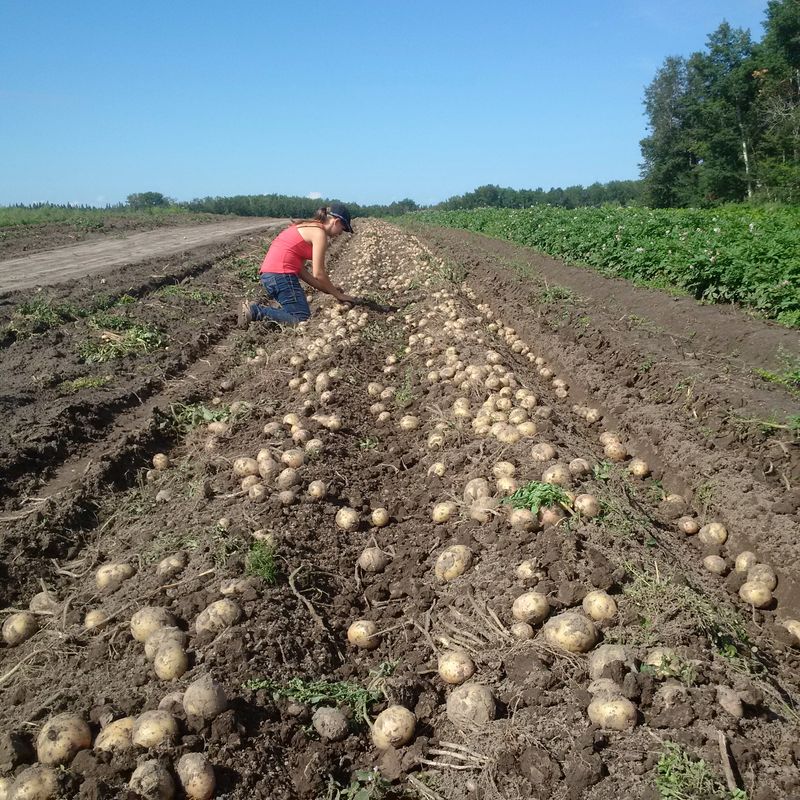 She points out how one of the most well-known potatoes in North America, the Russet, for example, is also one most likely to spike sugar levels – harmful for those with diabetes. Fewer people are aware of Fingerling, or Nicola potatoes, which are lower-starch varieties that the body can digest more slowly. It’s been the Shelton’s mission to not only grow and raise good, organic good, but to help educate their community on nutrition and growing their own quality produce. Janice and Jolene sometimes teach nutrition and gardening workshops in the local schools and wider community.
She points out how one of the most well-known potatoes in North America, the Russet, for example, is also one most likely to spike sugar levels – harmful for those with diabetes. Fewer people are aware of Fingerling, or Nicola potatoes, which are lower-starch varieties that the body can digest more slowly. It’s been the Shelton’s mission to not only grow and raise good, organic good, but to help educate their community on nutrition and growing their own quality produce. Janice and Jolene sometimes teach nutrition and gardening workshops in the local schools and wider community.
“Sometimes people ask us, ‘Aren’t you shooting yourself in the foot to teach others to grow food when you sell vegetables?’” laughs Ty. “But the answer is no. First, take care of yourself, then help others. The goal is to help feed your community.”
A history of organic, biodiverse, and biodynamic production
“We’ve always looked outside of the box,” explains Ty.
The Sheltons have experimented with a little bit of everything. In the 1980s, they raised trout in ponds and grew wild rice and quinoa “when no one ever knew what it was.” But without the facilities to process quinoa, they didn’t continue growing the crops. They raised Rhea for fats and oils to sell for cosmetics, then eventually got into direct marketing of potatoes. At one point they were managing 80 acres of potatoes, although, today they’re down to 20 acres of production.
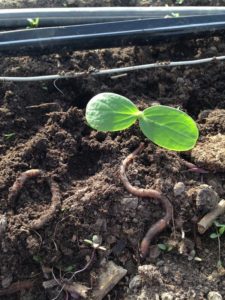 Marketing is always an issue for farmers, but farmers in northern Alberta face additional challenges of transport and access to both processing facilities and markets. The family has navigated these challenges – along with uncertainties around market fluctuation and cycling weather patterns – by diversifying every aspect of their production. Diversifying helps protect them against uncertainty.
Marketing is always an issue for farmers, but farmers in northern Alberta face additional challenges of transport and access to both processing facilities and markets. The family has navigated these challenges – along with uncertainties around market fluctuation and cycling weather patterns – by diversifying every aspect of their production. Diversifying helps protect them against uncertainty.
“We can market our potatoes as seed potatoes or sell them as table potatoes – conventional or organic – it doesn’t matter. We sell right to the stores, to farmer’s markets, or to other potato growers. We can sell our beef conventionally, organically, grass-fed, as calves, or as finished animals. Diversifying is really about it’s about.”
Both Ty and Janice grew up on farms, although their parents relied on chemical inputs. As a young couple starting out on the land, the decision to go organic in the 1980s was more about lack of funds (not being able to afford costly fertilizers), but they began to realize they didn’t need chemicals. “We began educating ourselves on naturally paying attention to the land and how we could increase our soil health through organic production,” says Janice.
“We basically went back to the way our great-grandparents used to farm,” agrees Ty. “They followed moon cycles. We started following the old ways.”
The Sheltons practice biodynamic farming, a form of ecological and organic agriculture, rooted in the work of philosopher and scientist, Dr. Rudolf Steiner. Biodynamic farming has evolved from the 1920s to involve a number of specific practices that aim to improve plant vitality by strengthening plant, soil, and environmental interactions.
“Biodynamic farming is a way of looking at your farm as a whole. Everything contributes to the other,” explains Janice. “We work with the energetics of the moon cycles. For example, tides flow with the gravitational pull of the moon – and this same gravitational pull is also affecting plant and plant life. There’s a time in nature for everything: to cultivate, weed, and harvest.”
The Sheltons use a tool called a BRIX metre, or a refractometer, a tool that measures the percentage of sucrose, or sugar levels, to determine the nutritional value in their crops and vegetables before harvesting.
“If there’s a storm coming in, you test your Brix levels on your alfalfa, and you can actually see if it’s too low,” explains Ty. “The plants are smart enough to know a storm is coming – a hail storm, for example – and they so they store their nutrients in the roots to protect themselves. When it comes to vegetables, we do the same thing. We won’t harvest if the nutrient content is low – we’ll plough it under and feed the soil.”
Jolene and Janice bring the BRIX meter into the local classrooms and the community to demonstrate the nutritional differences between home-grown, freshly harvested produce and imported produce purchased in the grocery stores. “We’re trying to show people, what you reap in the garden, you can’t compare to in the grocery store,” says Jolene. “When they test their own vegetables, they realize what they’re growing is way more nutritious.”
Organic soil management through rotational grazing & multi-species cropping
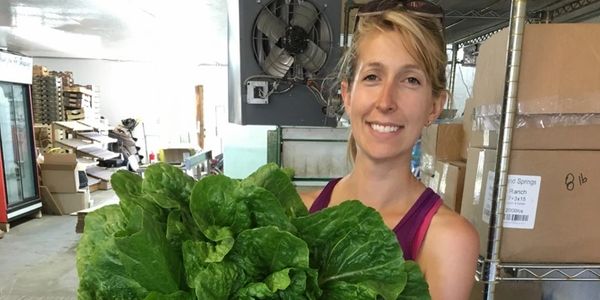 Jolene, who manages the family’s market garden – 20 acres of vegetable production – says that online sales have more than doubled since the onset of the COVID-19 global pandemic. The family used to offer a weekly CSA box program, but today customers can choose from all farm-products on an online market and build their own orders. The Sheltons even provide delivery. As a result, sales have increased, and admittedly, her administration duties, too – but it’s all worth it, she says. They also include products from a local bakery, dried herbs, and saskatoons from local growers.
Jolene, who manages the family’s market garden – 20 acres of vegetable production – says that online sales have more than doubled since the onset of the COVID-19 global pandemic. The family used to offer a weekly CSA box program, but today customers can choose from all farm-products on an online market and build their own orders. The Sheltons even provide delivery. As a result, sales have increased, and admittedly, her administration duties, too – but it’s all worth it, she says. They also include products from a local bakery, dried herbs, and saskatoons from local growers.
When it comes to soil management, the Sheltons are always looking at least ten years ahead.
“We don’t use compost,” explains Jolene, referring to their soil management practices. “Instead, we utilize our livestock and do rotational grazing, and plant green manures.”
For exceptionally weedy areas, they rely on the pigs for weed-control.
“The pigs dig up the roots, till the land, and eat the weeds – that’s what they want. We really appreciate the pigs doing that for us,” adds Janice.
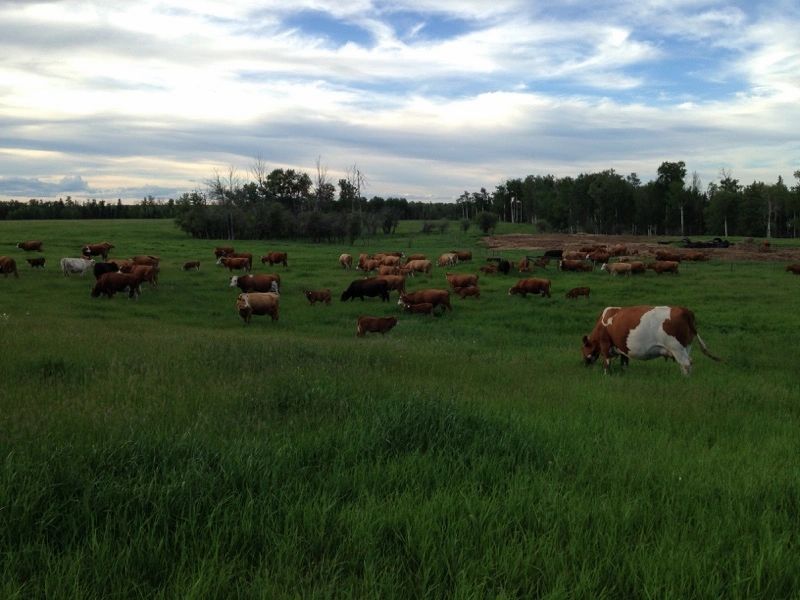 The Sheltons are always planning far into the future, mapping out the rotational grazing of their cattle on different fields, followed by planting different species of crops, which increases the microbiology in the soil. They plant oats, peas, turnip, tillage radish, and kale as multi-species cropping. This absorbs and deposits different nutrients into the soil for summer grazing of their cattle. The cattle, in turn, eat the remaining crops, recycle nutrients back into the soil, and results in minimum impact and till. The Sheltons do their best to practice no-till agriculture (although it’s not always possible for, say, potato production), as tilling can destroy soil microbiology.
The Sheltons are always planning far into the future, mapping out the rotational grazing of their cattle on different fields, followed by planting different species of crops, which increases the microbiology in the soil. They plant oats, peas, turnip, tillage radish, and kale as multi-species cropping. This absorbs and deposits different nutrients into the soil for summer grazing of their cattle. The cattle, in turn, eat the remaining crops, recycle nutrients back into the soil, and results in minimum impact and till. The Sheltons do their best to practice no-till agriculture (although it’s not always possible for, say, potato production), as tilling can destroy soil microbiology.
“The soil is the dictator as to what we do – so we do our best to listen,” says Ty. “It all starts with the soil. It doesn’t matter whether you’re organic, or not, if you have unhealthy soil, you have a lower quality product. Feed the soil first. Feed the soil before you feed yourself.”
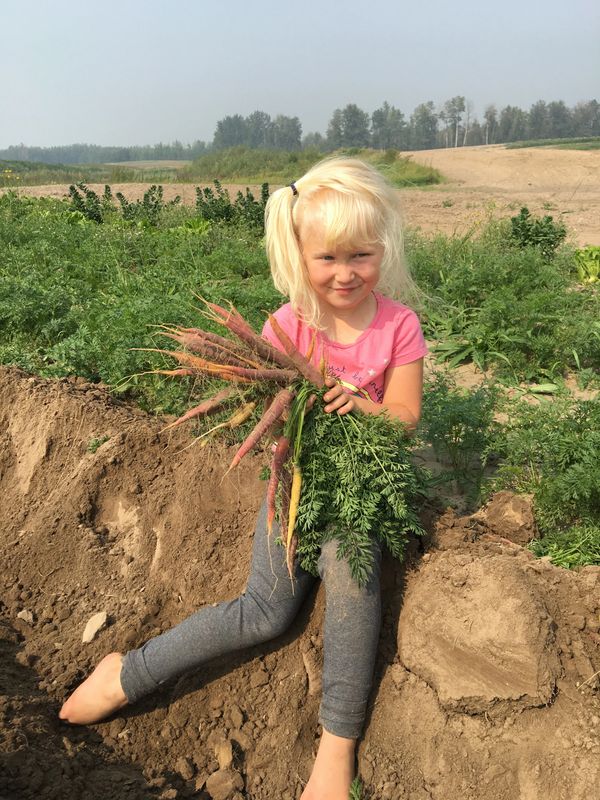 Hope for increased regional food security – imagining the future of “food hubs”
Hope for increased regional food security – imagining the future of “food hubs”
The Sheltons are deeply committed to increasing access to good, nutritious, organically raised and grown food in the La La Biche region. Recently, they’ve been advocating for a local and regional “Food Hub” which would provide markets for local producers and local food for consumers.
“At the start of the COVID-19 pandemic, people went to the grocery stores and saw empty shelves, and that frightened them,” Janice points out.
“People are aware more so now than ever about growing their own food,” agrees Ty. “They’re thinking about it for a change.”
But the first obstacle to the food hub, says Janice, is to “grow the growers.” They hope to see other organic, regenerative producers – who have an ethic for soil health – joining together to create the Food Hub. “We need other farms coming on board.”
The benefits of a local and regional food hub would be plentiful: increased accessibility of northern communities to organic, nutrient-dense food, increased marketing support and returns for local producers, reduced reliance on fossil fuels to transport food – and increased economy flow. Also, more time for producers to focus on growing food as opposed to marketing food, adds Janice.
“Why on earth are we bringing in so much food to our local grocery stores?” she wonders. “There has never been a better time to bring forth a food hub in rural communities.”
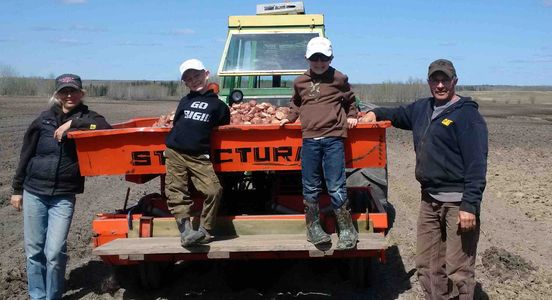
SAND SPRINGS RANCH
Sand Springs Ranch is a family-run operation in Lac La Biche, Alberta, managed by Ty and Janice Shelton, their daughter, Jolene, their son, Tyler, and their two grandsons. The Sheltons take a biodiverse, biodynamic, organic approach to stewarding healthy soil, and raising grass-finished beef, pasture-raised pork, and growing table and seed potatoes, and a wide variety of organic vegetables.
Learn more about Sand Springs Ranch – https://sandspringsranch.ca/our-farm

